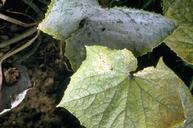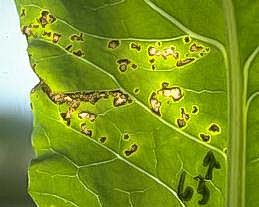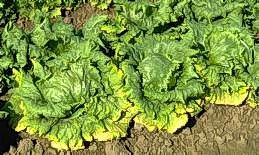Disease occurs when microscopic organisms (bacteria, fungi and viruses) infect plants, interfere with normal growth and cause damage or death. The signs and symptoms of the disease can give an indication of the pathogen involved, or at least the type of pathogen.
There are three general categories of disease-causing organisms: fungal, bacterial and viral pathogens. To read more and see examples of specific plant diseases go to the UC IPM website Plant Disease Index.
Fungi
About 10% of the hundred thousand known species of fungi infect plants and are the single most important cause of plant diseases. Some fungi have a wide range of hosts and others infect only a single plant species. They may damage any part of a plant. Symptoms include wilts, rots, mildews, rusts and leaf spots.
Pathogenic fungi grow on or through diseased tissue and aggregate to form a network that can often be seen with the naked eye. Fungi reproduce and spread by producing spores that are spread by wind, water, insects, birds, tools or on anything the spores contact. Fungi persists from season to season in soil and plant tissue, or as spores.
To cause disease, fungi require a susceptible host and favorable environmental conditions. Most fungi prefer slightly warm conditions and moisture. (Powdery mildew does not require free water to infect plants.) Fungal diseases can be prevented by modifying environmental conditions and by planting resistant varieties when available. The letters “V” and “F” indicate a hybrid tomato variety is resistant to the fungi that cause verticillium wilt and fusarium wilt diseases.

Bacteria
Of the 1600 known species of bacteria only about 100 are plant pathogens. They are microscopic, single celled organisms that multiply by dividing to form two cells. This can occur as often as every twenty minutes under warm moist conditions. Bacteria require a wound or natural opening to enter and infect a susceptible plant. They may damage any part of a plant and cause spots (on leaves, stems, and fruit), blights (rapid tissue death), cankers (chronic lesions), galls, and wilts.
Bacteria are spread by wind, insects, splashing water (rain or sprinkler irrigation), and by humans on contaminated tools, hands, and diseased plant tissue. Bacteria can survive for many months in a dormant state on seeds, in infected plant tissues, and in the bodies of insect vectors. Bacterial diseases can be prevented with good sanitation and by modifying environmental conditions that favor the spread and growth of bacteria.

Viruses
About 25% of the more than two thousand known viruses cause plant diseases. Viruses are non-living microscopic structures containing genetic material (RNA or DNA). They reproduce by entering the cells of a host and causing them to produce more virus particles. Viruses spread throughout a plant and remain in the plant for its life.
Plants infected with a virus usually do not die but may be weak or stunted and exhibit symptoms of discoloration (e.g., such as ring spots, mosaics and loss of color pigment in flowers), deformed leaves and flowers, and reduced fruiting. Viruses are mechanically spread from plant to plant by aphids and other insect vectors, and by humans on contaminated hands and tools, and on seed.
Virus diseases can be prevented by controlling insect vectors and by planting varieties resistant to a particular virus. The letter “T” indicates that a hybrid tomato variety is resistant to tobacco mosaic virus.

Controlling Plant Pathogens
Several good practices minimize infection from plant pathogens. Be sure to:
-
- Practice good sanitation. Keep disease-causing organisms out of the garden. If you have a disease problem, dispose of the infected material immediately. Seal it in a plastic bag and put into the trash. Do not add it to the compost. Do not move plants or soil from another location to your garden since this can introduce diseases, pests, and weeds.
- Purchase clean stock plants. Start with clean material and you will minimize disease problems.
- Monitor the garden frequently. With daily, weekly, or monthly monitoring you can catch disease problems early.
- Provide adequate nutrition. Plants that are receiving adequate nutrition are less likely to suffer from disease. Fertilize regularly.